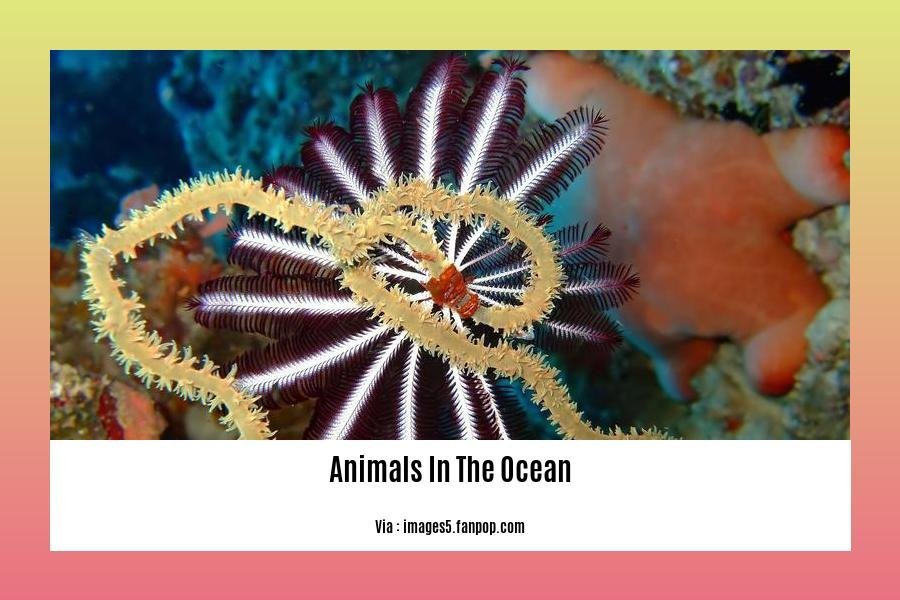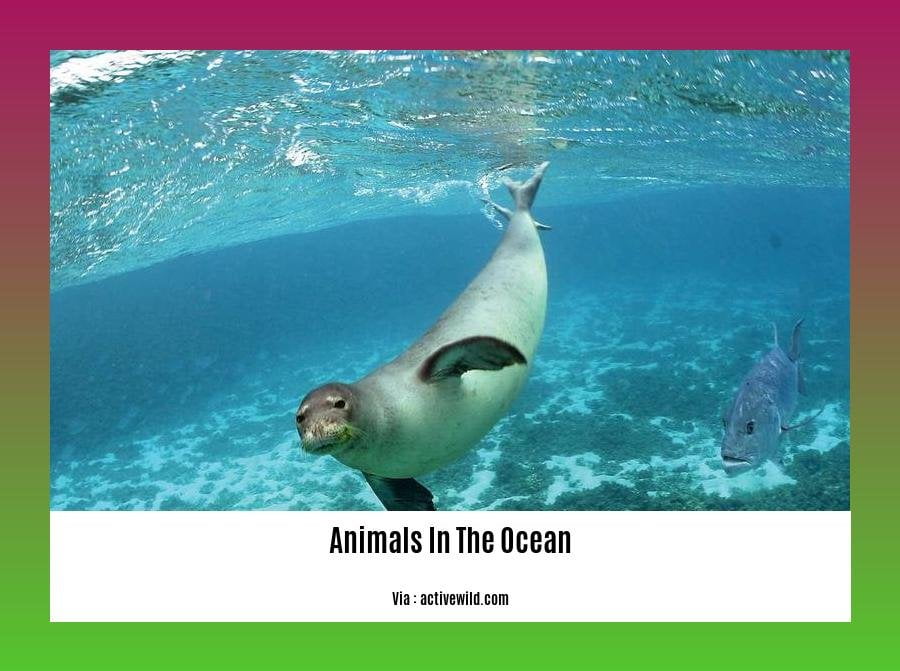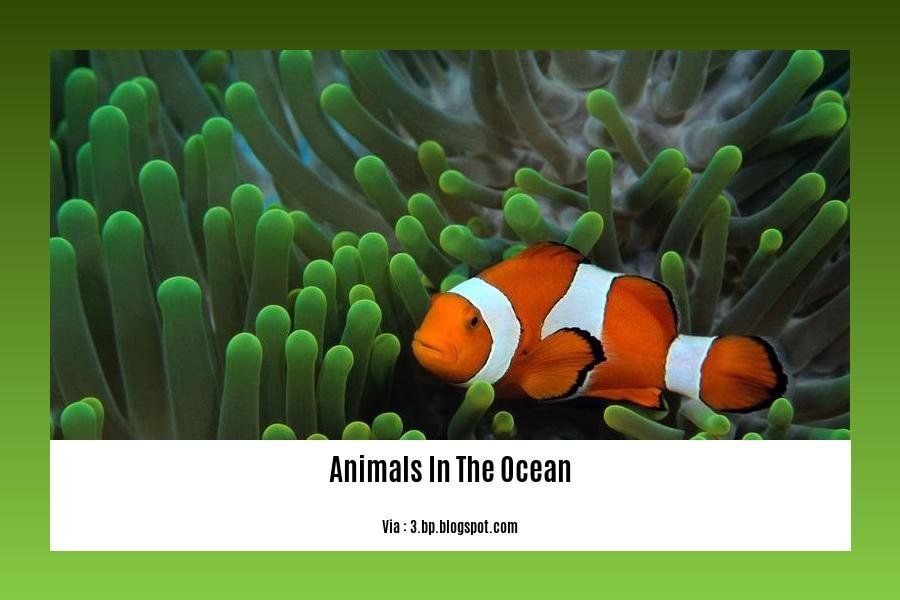Discover the fascinating fun facts about animals in the ocean and plunge into the mesmerizing world beneath the waves. With years of research and fieldwork, our expert marine biologist unveils a wealth of knowledge about the diverse and enchanting creatures that inhabit the deep seas and coral reefs. From the intriguing mating rituals of seahorses to the awe-inspiring navigational abilities of sea turtles, join us on a captivating journey into the secrets of the underwater realm.
Key Takeaways:
- Seahorses are the only animals where the male gives birth and cares for their young.
- A shrimp’s heart is located in its head.
- Sea sponges are alive but lack organs like a brain or heart.
- Turtles can be found on every continent except Antarctica.
- The blue whale is the largest known animal in the world.
- Sea turtles have been around since the time of dinosaurs.
- Sea otters have a special pocket of skin near their armpits to store food.
- Beluga whales have a unique language and can mimic human speech.
Fun Facts about Animals in the Ocean

Have you ever wondered about the incredible and awe-inspiring creatures that dwell beneath the ocean’s surface? The ocean is a vast expanse teeming with life, from the smallest microscopic organisms to the colossal giants that roam the depths. In this article, we will dive into a world of fascinating fun facts about animals in the ocean.
Seahorses: Amazing Fathers of the Sea
Did you know that seahorses are the only animals in which the males, not the females, give birth and care for their young? It’s true! These enchanting creatures defy the norms of nature with their incredible breeding habits. The male seahorse carries the eggs in a special pouch until they hatch, releasing dozens or even hundreds of miniature seahorses into the world. It’s a marvel to witness this nurturing behavior of seahorse fathers, a remarkable example of paternal care in the animal kingdom.
Shrimp: A Heart in the Head
Prepare to have your mind blown by another intriguing fact—shrimp have their heart located in their head! This unique anatomical arrangement sets them apart from most animals. While it may sound peculiar, this adaptation actually helps shrimp pump blood to their eyes, antennae, and other parts of their body. It’s a clever evolutionary solution that ensures efficient circulation in these fascinating ocean dwellers.
Sea Sponges: Simplicity in Survival
In stark contrast to more complex organisms, sea sponges lack organs such as a head, mouth, eyes, feelers, bones, heart, lungs, or even a brain, and yet they are alive! Despite their simplistic structure, these incredible creatures thrive in the ocean. How do they survive without these vital components, you may ask? Sea sponges rely on specialized cells to perform essential functions like absorbing nutrients and expelling waste. Their ability to adapt and thrive demonstrates that simplicity can indeed be a successful survival strategy in the vast ocean ecosystem.
Turtles: World Travelers
While most animals are confined to specific habitats, turtles have managed to conquer the world’s oceans. These resilient creatures can be found living on every continent except Antarctica. From the tropical beaches of the Caribbean to the icy waters of the Arctic, turtles have adapted to various environments and provide a remarkable example of the adaptability and versatility of ocean animals.
Blue Whales: Kings of the Ocean
If you’re ready to be amazed by sheer size, look no further than the blue whale. As the largest known animal in the world, this magnificent sea creature can grow to an astonishing length of up to 100 feet and weigh over 200 tons. To put it into perspective, imagine a breathtaking creature spanning the length of a basketball court and weighing as much as 25 elephants! The mere existence of such colossal beings highlights the wondrous diversity of life beneath the ocean’s surface.
Sea Turtles: Survivors through Time
Sea turtles have been around for an incredibly long time, even predating the dinosaurs. These ancient reptiles have existed on Earth for over 150 million years, successfully weathering the test of time. It’s awe-inspiring to contemplate how these resilient creatures have adapted and thrived throughout the ages, providing a living connection to our planet’s prehistoric past.
Sea Otters: Nature’s Secret Stash
Sea otters possess a secret pocket of skin near their armpits where they store food. Yes, you read that correctly! These adorable and resourceful creatures tuck their favorite snacks away in the pouch-like skin fold, ensuring they always have a tasty treat at paw’s reach. It’s an ingenious strategy for sea otters to savor their food while floating effortlessly on their backs, basking in the beauty of the ocean.
Beluga Whales: Singers of the Sea
Did you know that beluga whales have their very own language of chirps and squeaks? This unique form of communication has earned them the nickname “canaries of the sea.” Remarkably, beluga whales can even mimic human speech, adding to the intrigue and fascination surrounding these intelligent marine mammals. Imagine having a conversation with a whale!
As we conclude our journey through the captivating world of ocean animals, we hope these fun facts have deepened your appreciation for the marvelous creatures that call the ocean home. From the extraordinary role of seahorse fathers to the incredible adaptations and undeniable charm of shrimp, sea sponges, turtles, blue whales, sea turtles, sea otters, and beluga whales, each species offers a window into the intricate and awe-inspiring web of life beneath the waves. So, the next time you find yourself gazing out at the ocean, take a moment to marvel at the wonders that lie beneath—nature’s hidden treasures awaiting discovery.
Did you know that freshwater fish have some fascinating facts? Learn more about freshwater fish facts by clicking here!
If you’re looking for detailed information on freshwater fish, check out our extensive guide here.
Looking for fun facts about aquatic animals? Click here to dive into an interesting and entertaining read!
Discover the Fascinating Fun Facts about the Camouflage Techniques of Octopuses

The ocean is home to an array of captivating creatures, each with their own unique attributes and abilities. Among these remarkable animals, octopuses stand out for their incredible camouflage techniques. These intelligent cephalopods possess a range of fascinating adaptations that allow them to seamlessly blend into their surroundings, making them true masters of disguise.
Octopuses have specialized cells called chromatophores in their skin, which play a vital role in their camouflage abilities. These remarkable cells contain pigment sacs and tiny muscles that allow them to change color and shape in an instant. With the ability to manipulate their chromatophores through muscular and neural control, octopuses can transform their appearance in milliseconds, impressively adapting to their environment with precision and speed.
Not only can octopuses change their color, but they can also mimic the texture of their surroundings. By altering the bumps and patterns on their skin, they can resemble various objects underwater, such as rocks, seaweed, or even other marine creatures. This remarkable textured camouflage adds another layer of concealment, making it even harder for predators to spot them.
The camouflage techniques employed by octopuses serve as vital defense mechanisms in their quest to evade predation. By seamlessly blending into their surroundings, octopuses can hide from potential threats, as well as mimic other organisms to confuse and deter predators. This effective camouflage provides them with a significant evolutionary advantage, allowing them to survive and thrive in their diverse habitats.
What makes octopuses’ camouflage techniques even more awe-inspiring is the fact that different species have their own unique ways of camouflaging. Some octopuses can change their appearance over 150 times per hour when searching for food, showcasing their exceptional adaptability and versatility in their environment. These remarkable creatures continue to surprise researchers with their stunning camouflage abilities, constantly pushing the boundaries of what we know about the natural world.
It is important to note that octopuses are not the only animals that employ camouflage in the ocean. Other cephalopods, such as squid and cuttlefish, also possess similar abilities to blend into their surroundings. However, octopuses have gained a reputation as one of the most intelligent animals in the oceans, making their camouflage techniques even more compelling.
In conclusion, the camouflage techniques of octopuses are truly captivating. Through their specialized skin cells, octopuses can change both their color and shape, mimicking their surroundings and effectively hiding from predators. Their remarkable adaptations and evolutionary advantage make them one of the most intriguing creatures of the deep seas. The more we learn about the camouflage techniques of octopuses, the more we appreciate the mesmerizing complexity of the marine world.
Key Takeaways:
- Octopuses have specialized cells called chromatophores in their skin that allow them to change color and shape.
- By manipulating their chromatophores, octopuses can blend into their surroundings and mimic various objects underwater.
- Camouflage is a defense mechanism that helps octopuses evade predation.
- Different species of octopuses have their own unique ways of camouflaging, showcasing their adaptability.
- Octopuses are considered one of the most intelligent animals in the oceans, adding to the intrigue of their camouflage techniques.
Sources:
- Octopus Camouflage Uncovered: The Science Behind Their Smart Skin
- 41 Outstanding Octopus Camouflage Facts That You Should Know!
The Remarkable Symbiotic Relationships in Coral Reefs
Coral reefs are not only visually stunning and biodiverse ecosystems, but they are also home to a wide range of fascinating symbiotic relationships. These intricate partnerships between different organisms contribute to the overall health and resilience of coral reefs. From mutualistic associations to clever mimicry, the symbiotic relationships in coral reefs are truly remarkable.
Mutualism: Helping Each Other Thrive
Mutualism is a win-win relationship where both species benefit from their interaction. In coral reefs, one of the most well-known examples of mutualism is the relationship between sea anemones and clownfish. The clownfish find protection from predators among the stinging tentacles of the sea anemone, while the anemone benefits from the clownfish’s presence by receiving nutrients and protection from predators. It’s an example of teamwork in the underwater world!
Parasitism: Exploiting for Gain
In contrast to mutualism, parasitism involves one organism benefiting at the expense of the other. While parasitic relationships are less common in coral reefs, they do exist. For example, certain species of parasites called gnathiids feed on the blood of reef fishes. These tiny parasites can cause harm to the host, but they play a role in the delicate balance of the coral reef ecosystem.
Commensalism: Taking Without Giving
Commensalism is a relationship where one organism benefits without harming or benefiting the other. Although commensalism is not as prominent in coral reefs, some creatures do take advantage of this type of relationship. For instance, remoras, also known as suckerfish, attach themselves to larger marine animals such as sharks or turtles. The remoras benefit from easy access to food scraps, while the larger animals are largely unaffected.
Mimicry: Mastering Deception
Mimicry in coral reefs is a clever survival tactic where one organism evolves to resemble another, often harmful, organism. By imitating their venomous or toxic counterparts, these mimics gain protection from predators. One fascinating example of mimicry in coral reefs is the bluestreak cleaner wrasse. This small fish imitates the appearance and behavior of a larger, predatory fish, giving it access to a continuous supply of tasty parasites from other reef fish.
Key Takeaways:
- Coral reefs host an array of symbiotic relationships, including mutualism, parasitism, commensalism, and mimicry.
- Mutualism is a mutualistic relationship where both species benefit, such as the partnership between sea anemones and clownfish.
- Parasitism entails one organism benefiting at the expense of another, a less common interaction in coral reefs.
- Commensalism occurs when one organism benefits without affecting the other, seen in the relationship between remoras and larger marine animals.
- Mimicry is a defensive strategy where one organism imitates another, allowing it to gain protection from predators.
Sources:
- Biology LibreTexts
- Scientificing
The extraordinary adaptability of deep-sea creatures
The ocean is a mysterious realm, teeming with a diverse array of creatures that have adapted to survive in the extreme conditions of the deep sea. These fascinating animals have developed remarkable features and behaviors that allow them to thrive in the darkness and pressure of the ocean’s depths. From the elusive barreleye fish to the terrifying frilled shark, let’s explore the extraordinary adaptability of deep-sea creatures.
Barreleye Fish: Vision in the Darkness
One of the most intriguing deep-sea creatures is the barreleye fish, also known as the spook fish. It possesses a truly extraordinary adaptation that enables it to see in pitch-black waters. The barreleye fish has a transparent scalp that allows it to navigate through the depths with ease. The membrane covering its head serves a dual purpose: it protects the fish’s delicate eyes from the stings of siphonophores while also providing a crucial shield against the intense pressure of the deep sea.
Deep Sea Spiders: Masters of Survival
Deep-sea spiders are another group of creatures that display incredible adaptability. These spiders have been found as deep as 2,300 feet in every ocean, proving their ability to withstand extreme conditions. They feed on slow-moving marine organisms such as sea nettles and sponges. Their unique feeding habits and ability to thrive in the deep sea make them true masters of survival.
Frilled Shark: A Living Fossil
The frilled shark is a creature straight out of a prehistoric nightmare. With its eel-like body and snake-like head, it is a deep-sea predator that has remained virtually unchanged for millions of years. Its most distinctive feature is its frilled gills, which provide the shark with enhanced oxygen absorption in the oxygen-deprived waters of the deep sea. This adaptation allows the frilled shark to survive in the depths where other creatures would struggle.
Key Takeaways:
- The barreleye fish possesses a transparent scalp that enables it to see in pitch-black waters and avoids the stings of siphonophores.
- Deep-sea spiders can be found as deep as 2,300 feet in every ocean, showcasing their adaptability to extreme conditions.
- The frilled shark is a prehistoric creature with frilled gills that enhance its oxygen absorption in the oxygen-deprived deep-sea environment.
Sources:
FAQ
Q1: Do seahorses really give birth to their young?
A1: Yes, seahorses are the only animals in which the male, not the female, gives birth and cares for their young.
Q2: Where is a shrimp’s heart located?
A2: A shrimp’s heart is located in its head.
Q3: How do sea sponges survive without organs?
A3: Sea sponges lack organs such as a head, mouth, eyes, feelers, bones, heart, lungs, or brain, yet they are alive.
Q4: Are there turtles in every continent?
A4: Turtles can be found living on every continent except Antarctica.
Q5: Which animal is the largest known in the world?
A5: The blue whale, which is a sea mammal, is the largest known animal in the world.
- Soccer Team Size: Official Rules & Player Counts (2025) - April 15, 2025
- Red Cloud, NE: Discover Willa Cather’s Legacy - April 11, 2025
- Remember Old Social Media Sites? Their Rise and Fall - April 11, 2025
















